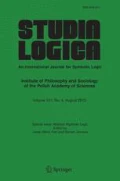Abstract
Motivated by applications in software engineering, we propose two forms of combination of logics: synchronization on formulae and synchronization on models. We start by reviewing satisfaction systems, consequence systems, one-step derivation systems and theory spaces, as well as their functorial relationships. We define the synchronization on formulae of two consequence systems and provide a categorial characterization of the construction. For illustration we consider the synchronization of linear temporal logic and equational logic. We define the synchronization on models of two satisfaction systems and provide a categorial characterization of the construction. We illustrate the technique in two cases: linear temporal logic versus equational logic; and linear temporal logic versus branching temporal logic. Finally, we lift the synchronization on formulae to the category of logics over consequences systems.
Similar content being viewed by others
References
M. Arrais and J. Fiadeiro , 1996, Unifying theories in different institutions, in: M. Haveraaen, O. Owe and O.-J. Dahl, (eds), Recent Trends in Data Type Specification, Springer-Verlag, LNCS 1130, 81–101
J. Barwise, 1974, Axioms for abstract model theory, Annals of Mathematical Logic, 7, 221–265
A. Blass, 1984, The interaction between category theory and set theory, in: J. W. Gray, (ed), Mathematical Applications of Category Theory, AMS Series in Contemporary Mathematics, 5–29
P. Blackburn and M.de Rijke, 1997, Why combine logics, Studia Logica, 59,1, 5–28
R. Burstall and J. Goguen, 1977, Putting theories together to make specifications, in: R. Reddy, (ed), Proc. 5th Intl. Joint Conf. on Artificial Intelligence, Cambridge, Massachusetts, 1045–1058
M. Cerioli and J. Meseguer, 1993, May I Borrow Your Logic, in: A. Borzyszkowski and S. Sokolowski, (eds), Mathematical Foundations of Computer Science 1993, LNCS, Springer-Verlag, 342–351
M. Finger and D. Gabbay, 1992, Adding a temporal dimension to a logic system, Journal of Logic, Language and Information, 1, 203–233
M. Finger and D. Gabbay, 1996, Combining temporal logic systems, Notre Dame Journal of Formal Logic, 37, 204–232
D. Gabbay (ed), 1994, What is a logical system?, Oxford Science Publications
D. Gabbay, 1996, An overview of fibred semantics and the combination of logics, in: F. Baader and K. Schulz, (eds), Frontiers of Combining Systems, Kluwer Academic Publishers, 1–55
J. Goguen and R. Burstall, 1992, Institutions: Abstract model theory for specification and programming, Journal of the ACM, 39,1, 95–146
R. Goldblatt, 1992, Logics of Time and Computation, CSLI. Second edition
J.-L. Lassez, V. L. Nguyen and E. A. Sonenberg, 1982, Fixed point theorems and semantics: A folk tale, Information Processing Letters, 14,3, 112–116
J. Fiadeiro and A. Sernadas, 1988, Structuring theories on consequence, in: D. Sannella and A. Tarlecki, (eds), Recent Trends in Data Type Specification, Springer-Verlag, 44–72
M. Kracht and F. Wolter, 1991, Properties of independently axiomatizable bimodal logics, Journal of Symbolic Logic, 56,4, 1469–1485
S. Mac Lane, 1971, Categories for the Working Mathematician, Springer-Verlag
M. Manzano, 1996, Extensions of First Order Logic, Cambridge University Press
J. Meseguer, 1989, General logics, in: H.-D. Ebbinghaus et al, (eds), Proceedings of the Logic Colloquium, 1987, North-Holland, 275–329
A. Tarlecki, 1996, Moving between logical systems, in: M. Haveraaen, O. Owe and O.-J. Dahl, (eds), Recent Trends in Data Type Specification, Springer-Verlag, LNCS 1130, 478–502
A. Tarski, 1956, On the concept of logical consequence, in: J. H. Woodger, (ed), Logic, Semantics, Metamathematics, Oxford Clarendon Press, 409–420
A. Tarski, 1955, A lattice-theoretical fixpoint theorem and its applications, Pacific Journal of Mathematics, 5, 285–309
R. Thomason, 1984, Combinations of tense and modality, in: D. Gabbay and F. Guenthner, (eds), Handbook of Philosophical Logic II, Kluwer Academic Publishers, 135–165
G. Winskel and M. Nielsen, 1995, Models of concurrency, in: S. Abramsky, D. Gabbay and T. Maibaum, (eds), Handbook of Logic in Computer Science 4, Oxford Science Publications, 1–148
M. Ben-Ari, Z. Manna and A. Pnueli, 1981, The temporal logic of branching time, in: 8th ACM Symposium on Principles of Programming Languages, Williamsburg, VA, 164–176. Also, Acta Informatica, 20(3):207–226, 1983
W. Penczek, 1988, A temporal logic for event structures, Fundamenta Informaticae, 11,3, 297–326
Author information
Authors and Affiliations
Rights and permissions
About this article
Cite this article
Sernadas, A., Sernadas, C. & Caleiro, C. Synchronization of Logics. Studia Logica 59, 217–247 (1997). https://doi.org/10.1023/A:1004904401346
Issue Date:
DOI: https://doi.org/10.1023/A:1004904401346



